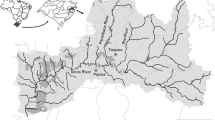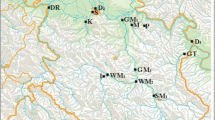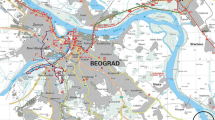Abstract
As a part of an exposure and effect monitoring conducted along the river Mureş, Western Romania in 2004, the health status of two indigenous fish species, sneep (Chondrostoma nasus) and European chub (Leuciscus cephalus) was investigated upstream and downstream the city of Arad. In fish, histopathology was assessed in liver and gills, and heavy metals (cadmium, copper, lead and zinc) were analyzed in liver samples. In both fish species, histopathological reactions in the gills (epithelial lifting, focal proliferation of epithelial cells of primary and secondary lamellae and resulting fusion of secondary lamellae, hyperplasia and hypertrophy of mucous cells, focal inflammation and necrosis of epithelial cells) were most severe at the two sampling sites upstream Arad city, which were shown to be polluted by copper, cadmium, faecal coliforms and streptococci in a parallel study. At these two sites, also histopathology in the liver of L. cephalus was more prominent than at the two downstream sites. In C. nasus, symptoms in the liver (focal inflammation with lymphocytic infiltrations, macrophage aggregates and single cell necrosis) were also highly pronounced at the sampling site located directly downstream the municipal sewage treatment plant of Arad. With the exception of copper accumulation in L. cephalus caught at the most upstream sampling site, in both fish species cadmium and copper accumulation were exceptionally high and did not differ significantly between the four sampling sites.
Similar content being viewed by others
References
Adams, S. M. (2000). Assessing sources of stress to aquatic ecosystems using integrated biomarkers. Biological resource management connecting science and policy (pp. 17–29).
Adams, S. M. (2002). Biological indicators of aquatic ecosystem stress: Introduction and overview. In Biological Indicators of Aquatic ecosystem stress. Am. Fish. Soc. (pp. 1–11). Bethesda, Maryland.
Adams, S. M., Bevelhimer, M. S., Greeley, M. S., Levine, D. A., & Teh, S. J. (1999). Ecological risk assessment in a large river-reservoir: 6: Bioindicators of fish population health. Environmental Toxicology and Chemistry, 18, 628–640.
Bohl, E., Kleisinger, H., & Leuner, E. (2003). Rote Liste Gefährdeter Fische (Pisces) und Rundmäuler (Cyclostomata) Bayerns. Bayr. LFU, 166, 52–55.
Burkhardt-Holm, P., & Bloesch, J. (2000). Fish as bioindicators for pollutants in the Danube River: An approach. Internat. Asoc. Danube Res., 33, 375–382.
Burkhardt-Holm, P., Peter, A., & Segner, H. (2002). Decline of fish catch in Switzerland. Project Fishnet: A balance between analyses and synthesis. Aquatic Sciences, 64, 36–54.
Dietze, U., Braunbeck, T., Honnen, W., Köhler, H.-R., Schwaiger, J., Segner, H. et al. (2001). Chemometric discrimination between streams based on chemical, limnological and biological data taken from freshwater fishes and their interrelationships. Journal of Aquatic Food Product Technology, 8, 319–336.
Freyhof, J. (1997). Remarks on the status of Chondrostoma nasus in the river Rhine. Folia Zoologica, 46, 61–66.
Frodello, J. P., Raqbi, A., Mattei, X., Viale, D., & Marchard, B. (2001). Quantification of macrophage aggregates in the liver of Mugil cephalus. Journal of Submicroscopic Cytology and Pathology, 33, 473–476.
Galloway, T. S., & Depledge, M. H. (2001). Immunotoxicity in invertebrates: measurement and ecotoxicological relevance. Ecotoxicology, 10, 5–23.
Ham, K. D., Adams, S. M., & Peterson, M. J. (1997). Application of multiple bioindicators to differentiate spatial and temporal variability from the effects of contaminant exposure on fish. Ecotoxicology and Environmental Safety, 37, 53–61.
Hamilton, S. J., & Mehrle, P. M. (1986). Metallothionein in fish: review of its importance in assessing stress from metal contaminants. Transactions of the American Fisheries Society, 115, 596–609.
Hamm, A. (ed.). (1991). Studie über die Wirkungen und Qualitätsziele von Nährstoffen in Fließgewässern, Academia-Verlag, St. Augustin, Germany.
Holcik, J. (2003). Changes in the fish fauna and fisheries in the Slovak section of the Danube river: a review. Annales de Limnologie, 39, 177–195.
Honnen, W., Rath, K., Schlegel, T., Schwinger, A., & Frahne, D. (2001). Chemical analyses of water, sediment and biota in two small streams in Southwest Germany. Journal of Aquatic Ecosystem Stress and Recovery, 8, 195–213.
IAD (2004). Water quality of the Danube and its tributaries 2002 (water quality map). IAD, Vienna, Austria.
Köhler, H.-R., Sandu, C., Scheil, V., Nagy-Petricã, E. M., Segner, H., Telcean, I., et al. (2007). Monitoring pollution in River Mureş, Romania, part III: Biochemical effect markers in fish and integrative reflection. Environmental Monitoring and Assessment, 127, 47–54.
Lam, P. K. S., & Gray, J. (2003). The use of biomarkers in environmental monitoring programmes. Marine Pollution Bulletin, 46, 182–186.
Lam, P. K. S., & Wu, R. S. S. (2003). Use of biomarkers in environmental monitoring. Background paper for STAP workshop Analytical methods for POPs. Tsukuba, Japan, Dec. 2003.
LAWA (1998). Beurteilung der Wasserbeschaffenheit von Fliessgewässern in der Bundesrepublik Deutschland - Chemische Gewässergüteklassifikation, Kulturbuchverlag, Berlin, Germany.
Mallat, J. (1985). Fish gill structural changes induced by toxicants and other irritants: A statistical review. Canadian Journal of Fisheries and Aquatic Sciences, 42, 630–648.
Müller, G., & Prosi, F. (1978). Distribution of zinc, copper, and cadmium in various organs of roaches (Rutilus rutilus L.) from the Neckar and Elsenz Rivers. Zeitschrift fur Naturforschung. 33C, 7–14.
Ognean, R.-C., Sandu, I., Kovács, P., & Buzás, Z. (1998). Mures/Maros. Report No. 1, Inception Report, Task Force on Monitoring and Assessment under the UN/ECE Water Convention, Pilot Project Programme Transboundary Rivers’, Targu Mures, Romania.
Pawert, M., Müller, E., & Triebskorn, R. (1998). Ultrastructural changes in fish gills as biomarker to assess small stream pollution. Tissue and Cell, 30, 617–626.
Pedroli, J.-C., Zaugg, B., & Kirchhofer, A. (1991). Verbreitungsatlas der Fische und Rundmäuler der Schweiz, Doc. Faun. Helvetiae 11, Centre Suisse de Cartographie de la Faune, Neuchatel, Switzerland, 207 pp.
Perkin-Elmer (1984). Analytical Techniques for Graphite Furnace Atomic Absorption Spectrometry. Publication: B332. Release: A3.0/January.
Roméo, M., Siau, Y., Sidoumou, Z., & Gnassia-Barelli, M. (1999). Heavy metal distribution in different fish species from the Mauritania coast. Science of the Total Environment, 232, 169–175.
Schmitt, C. J., Bartish, T. M., Blazer, V. S., Gross, T. S., Tillitt, D. E., Bryant, W. L., et al. (1999). Biomonitoring of environmental status and trends (BEST) Program: Contaminants and their effects in fish from the Mississippi, Columbia, and Rio Grande basins. In D. W. Morganwalp, & H. T. Buxton (Eds.), U.S. Geological Survey Toxic Substances Hydrology Program – Proceedings of the technical meeting. Charleston, S.C., March 8–12, 1999, Volume 2 of 3 – Contamination of hydrologic systems and related ecosystems, U.S. Geological Survey-Water Resources Investigations Report 99-4018B.W. Trenton, NJ, USA, pp. 437–446.
Schwaiger, J. (2001). Histopathological alterations and parasite infection in fish: indicators of multiple stress factors. Journal of Aquatic Ecosystem Stress and Recovery, 8, 231–240.
Schwaiger, J., Wanke, R., Adam, S., Pawert, M., Honnen, W., & Triebskorn, R. (1997). The use of histopathological indicators to evaluate contaminant-related stress in fish. Journal of Aquatic Ecosystem Stress and Recovery, 6, 75–86.
Schwaiger, J., Ferling, H., Mallow, U., Wintermayer, H., & Negele, R. D. (2004). Toxic effects of the non-steroidal anti-inflammatory drug diclofenac. Part I: Histopathological alterations and bioaccumulation in rainbow trout. Aquatic Toxicology, 68, 141–150.
Sindilariu, P. D., Bacalbasa-Dobrovici, N., Freyhof, J., & Wolter, C. (2002). The juvenile fish community of the lower Danube and the Danube Delta. International Association for Danube Research 34, 517–526.
Stephensen, F., Adolfsson-Erici, M., Celander, M., Hulander, M., Parkkonen, J., Hegelund, T., et al. (2003). Biomarker responses and chemical analyses in fish indicate leakage of polycyclic aromatic hydrocarbons and other compounds from car tire rubber. Environmental Toxicology and Chemistry, 22, 2926–2931.
Sures, B., & Knopf, K. (2004). Individual and combined effects of cadmium and 3,3′,4,4′,5-pentachlorobiphenyl (PCB 126) on the humoral immune response in European eel (Anguilla anguilla) experimentally infected with larvae of Anguillicola crassus (Nematoda). Parasitology, 128, 445–454.
Teh, S. J., Adams, S. M., & Hinton, D. E. (1997). Histopathologic biomarkers in feral freshwater fish populations exposed to different types of contaminant stress. Aquatic Toxicology, 37, 51–70.
Teh, S. J., Deng, D., Werner, I., Teh, F., & Hung, S. S. O. (2005). Sublethal toxicity of orchard stormwater runoff in Sacramento splittail (Pogonichthys macrolepidotus) larvae. Marine Environmental Research, 59, 203–216.
Ternes, T. (1998). Occurrence of drugs in German sewage treatment plants and rivers. Water Research, 32(11), 3245–3260.
Tillitt, D., & Papoulias, D. M. (2003). Closing the gap between exposure and effects in monitoring studies. Pure and Applied Chemistry, 75, 2467–2475.
Triebskorn, R. (2005). Physiological biomarkers and the trondheim biomonitoring system. In J. Lehr, & J. Keeley (Eds.), Water Encyclopedia: Water Quality and Resource Development, John Wiley and Sons, Inc., NJ, USA.
Triebskorn, R., Adam, S., Behrens, A., Beier, S., Böhmer, J., Braunbeck, T., et al. (2003). Establishing causality between pollution and effects at different levels of biological organization: The VALIMAR project. Human and Ecological Risk Assessment, 9, 171–194.
Triebskorn, R., Adam, S., Casper, H., Honnen, W., Pawert, M., Schramm, M., et al. (2002). Biomarkers as diagnostic tools for evaluating toxicological effects of past water quality conditions on stream organisms. Ecotoxicology, 11, 451–465.
Triebskorn, R., Böhmer, J., Braunbeck, T., Honnen, W., Köhler, H.-R., Lehmann, R., et al. (2001). The project VALIMAR (VALIdation of bioMARkers for the assessment of small stream pollution): Objectives, experimental design, summary of results, and recommendations for the application of biomarkers in risk assessment. Journal of Aquatic Ecosystem Stress and Recovery, 8, 161–178.
Triebskorn, R., Casper, H., Heyd, A., Eikemper, R., Köhler, H.-R., & Schwaiger, J. (2004). Toxic effects of the non-steroidal anti-inflammatory drug diclofenac. Part II: Cytological effects in liver, kidney, gills and intestine of rainbow trout (Oncorhynchus mykiss). Aquatic Toxicology, 68, 151–166.
Van Gestel, C. A. M., & van Brummelen, T. C. (1996). Incorporation of the biomarker concept in ecotoxicology calls for a redefinition of terms. Ecotoxicology, 5, 217–225.
Voigt, H.-R. (2004). Concentrations of mercury (Hg) and cadmium (Cd), and the condition of some coastal Baltic fishes. Environmentalica Fennica, 21, 1–22.
Author information
Authors and Affiliations
Corresponding author
Rights and permissions
About this article
Cite this article
Triebskorn, R., Telcean, I., Casper, H. et al. Monitoring pollution in River Mureş, Romania, part II: Metal accumulation and histopathology in fish. Environ Monit Assess 141, 177–188 (2008). https://doi.org/10.1007/s10661-007-9886-9
Received:
Accepted:
Published:
Issue Date:
DOI: https://doi.org/10.1007/s10661-007-9886-9




